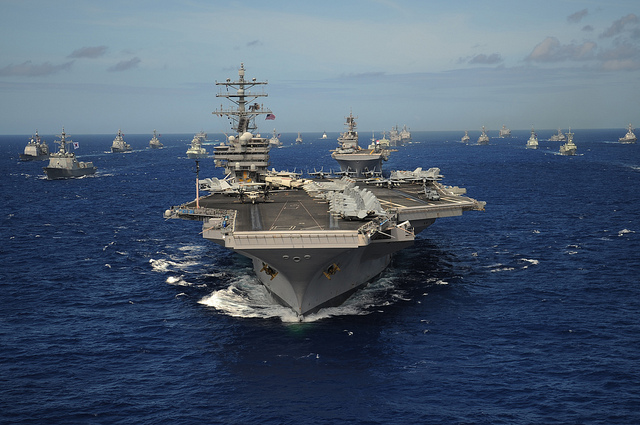We read the recent SDSC–CSIS report The ANZUS alliance in an ascending Asia (PDF) with interest. We agree with much of their analysis of alliance strengths and possible points of divergence in the face of growing Chinese military and economic power. But ultimately we don’t see ANZUS becoming ‘a central hub for Asian regional order and architecture’, however defined. Australia may have a role to play, but the crux of the policy challenges lies far to our north.
There are two ways ANZUS might be relevant—through physical geography as a platform for hard power and as a geopolitical player. Let’s start with the former. ANU/CSIS says:
Australia’s geographic location is more important to the United States today than it has been at any time since the Second World War. Australia serves both as a link between the Indian and Pacific Oceans and as a sanctuary from China’s anti-access/area denial capabilities.
That idea has a good pedigree, and the geographic importance of Australia to the US predates ANZUS by 50 years. Admiral Mahan thought the sea lines of communication between North America and Australia to be vitally important for sustaining American interests in the Pacific and that American (and European) outposts in North Asia and the Western Pacific were problematic without maritime supremacy. When American global naval power was nascent (in the Great White Fleet), Mahan thought dividing up the Pacific was the pragmatic approach, with the Western Pacific ‘remaining Asiatic’:
[t]he question awaiting and approaching solution is the line of demarcation between the Asiatic and European elements in the Pacific. The considerations advanced appear to indicate that it will be that joining Puget Sound and Vancouver with Australia…but there are outposts of European and American tenure in positions like the Marshall and Caroline Islands, Guam, Hongkong…
American naval power grew in leaps and bounds thereafter, and by the 1930s the USN could project substantial power into Asian waters. That came to an abrupt, if temporary, end following the Pearl Harbor attack in 1941. In Japanese controlled waters (and under Japanese controlled skies) the USN surface fleet was reduced to hit and run raids such as on the Japanese-occupied Marshall Islands in February 1942 and the later one-way ‘Doolittle raid‘ on Tokyo. Large areas of the Western Pacific being a no-go zone brought Australia to the fore, and as Ian Toll wrote in Pacific Crucible:
The entire Allied strategy in the Pacific depended on two cardinal points: Hawaii must not fall, and Australia must not fall…the new Pacific Fleet chief, Admiral Nimitz, [was ordered] to secure the seaways between Midway, Hawaii and the North American mainland. That was to be his first priority. The second, in only a ‘small degree less important’ was to protect the lifeline between North America and Australia…By those means the allied war machine would be built up in Australasia…
The near disaster at the hands of an expansionist Asian power and eventual salvation through American efforts led to the post-war Australian push for an alliance with the US. In other words, ANZUS was born out of Australian fears and offered the US the geographic advantages conferred by Australia’s ‘Goldilocks geography’—close enough to be a handy jumping point for a conflict with a North Asian power, but not so close to be at risk of being overrun in the early stages.
Seen through that lens, Australia as an in extremis hub of the US alliance structure in the Pacific makes sense. The US needed our geography before—at first because it lacked power of its own and later when its power came under challenge. With the rise of China and its technological challenges to US naval power, it’s tempting to conclude that our moment has again come and that the US will embrace Australia as its military home away from home in this part of the world.
But Australia as a modern military ANZUS hub is neither necessary nor desirable. Nuclear submarines, bombers with global range and ICBMs can now project American power across the Pacific; Hawaii remains well-placed to support US forces and Australia is a long way from North Asia, so any geographic advantage of staging from here is negligible. It takes a long time to project air or maritime power from Australia to the South China Sea, let alone to Northeast Asia.
So Australia represents, at best, part of a ‘defence in depth’ posture for the US military, and a fall-back option. But there are so many American interests in North Asia that much would have to go wrong—as it admittedly did in 1942—to make Australia ‘central’. In that case we’d be central to a significantly weakened United States, and much of the value of the alliance would’ve already been lost. That means that the value of any enhanced role for ANZUS needs to be a political one in shaping the security environment. We’ll return to that aspect tomorrow.


